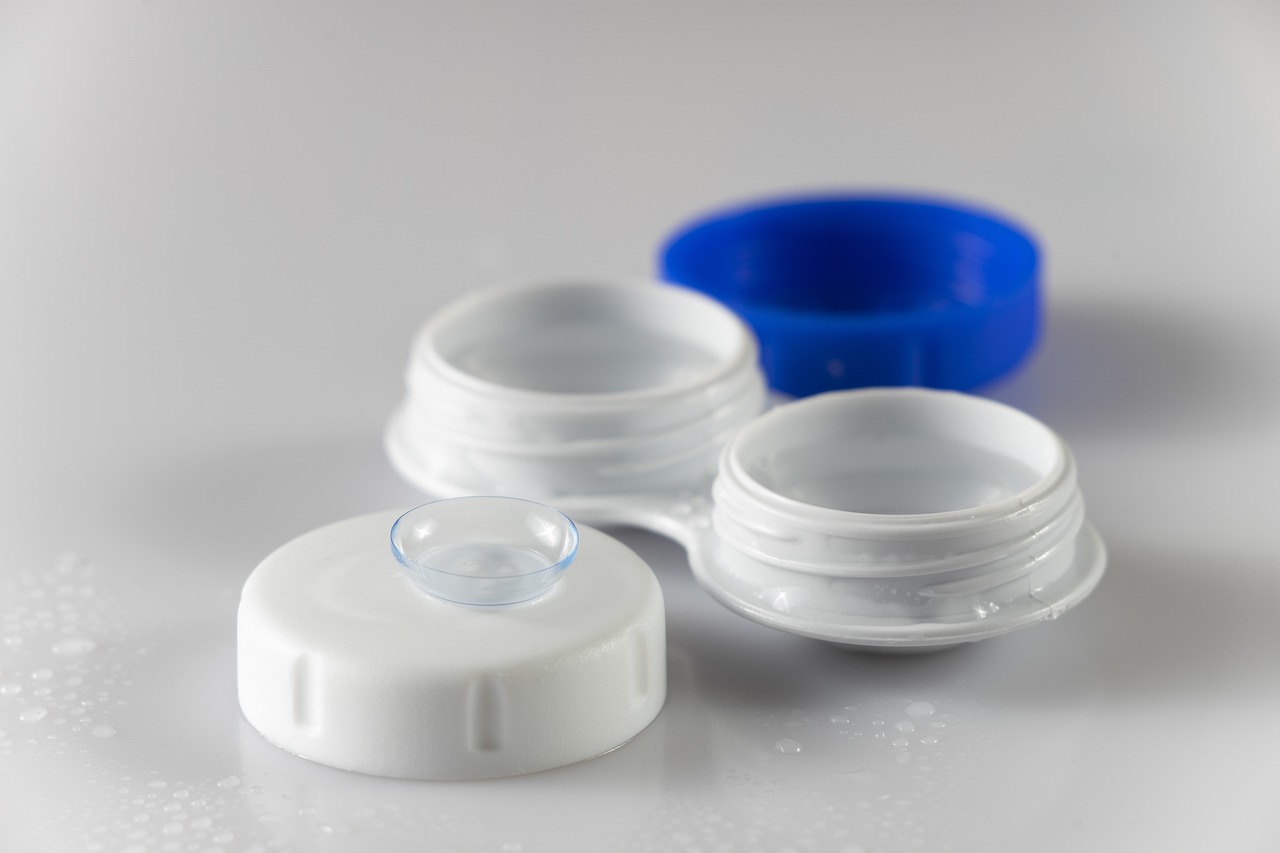Contact lenses Usage Statistics Worldwide

The worldwide market for contact lenses reached 17.14 billion in 2022 and is estimated to increase steadily.
By 2030, it's expected to reach $24 billion. This growth reflects a rising demand for contact lenses across the globe, with more people opting for them for vision correction.
The market is projected to expand further as technological advancements improve lens comfort and convenience, making them more appealing to consumers.
Table of Contents
- Contact lens Statistics: Highlights
- Brief History of Contact lens
- Top 10 Contact lens Usage Statistics
- How Many Contact lens Users Are There?
- Contact lens User Growth In America
- How many contact lenses are sold each year?
- Contact lens Usage by Age
- Contact lens Usage by Designs
- Contact lens Adoption Rate by Region
- Global contact lenses market
- Contact lens manufacturers
- Contact Lens Usage Complication Statistics
- Wrap Up
Contact lens Statistics: Highlights
The global contact lenses market reached a value of USD 17.14 billion in 2022 and is anticipated to grow to USD 18.6 billion by 2023. This upward trend reflects the increasing demand for contact lenses worldwide.
Factors such as rising cases of refractive errors and advancements in lens technology are driving market growth.
As more people opt for contact lenses for vision correction, the market is expected to continue expanding in the coming years.
Brief History of Contact lens
Here's a brief history of contact lenses:
- 1508: Leonardo da Vinci first conceived the idea of contact lenses, sketching a concept for corneal contact lenses.
- 1887: Physicist F.A. Müller developed the first known contact lens made of glass, intended to cover the entire eye.
- 1936: Optometrist William Feinbloom introduced the first contact lenses made of plastic, improving comfort and wearability.
- 1948: Kevin Tuohy developed the first corneal contact lens, fitting directly onto the cornea and covering only the front of the eye.
- 1950s: The popularity of contact lenses grew, primarily among those seeking an alternative to glasses for cosmetic reasons.
- 1970s: The introduction of soft contact lenses made from hydrogel materials significantly enhanced comfort and wearability.
- 1980s-1990s: Continuous advancements in materials and manufacturing processes improved oxygen permeability and extended wear options.
- 2000s-present: Contact lenses continue to evolve with innovations such as silicone hydrogel materials, multifocal lenses, and daily disposables, offering improved vision correction and comfort.
Throughout history, contact lenses have undergone significant technological advancements, becoming a widely accepted and accessible vision correction option for millions of people worldwide.
Also read about medical device usage statistics worldwide
Top 10 Contact lens Usage Statistics
- The global revenue of the Contact Lenses market is forecasted to reach US$19.28 billion in 2024.
- Projected Compound Annual Growth Rate (CAGR) from 2024 to 2028 stands at 3.87%, indicating steady market growth.
- The United States is a significant contributor to the market, expected to generate US$6,049 million in revenue in 2024.
- On a per-person basis, the Contact Lenses market is estimated to generate US$2.49 in revenue worldwide in 2024.
- By 2028, the volume of the Contact Lenses market is expected to reach 8.4 billion pieces.
- Anticipated volume growth of 2.3% is projected for the market in 2025.
- The average volume per person in the Contact Lenses market is expected to be 1.0 piece in 2024.
- It's essential to monitor trends and developments in the Contact Lenses market, particularly in the United States, to grasp its global performance.
- Notably, the demand for daily disposable contact lenses is rising in the United States due to their convenience and hygiene benefits.
How Many Contact lens Users Are There?
The global demand for contact lenses is evident with over 140 million wearers worldwide, including more than 45 million in the United States alone. This substantial number highlights the widespread popularity and necessity of contact lenses for vision correction.
Also read Refractive Error Statistics
Contact lens User Growth In America
In 2022, the global contact lenses market was valued at approximately $17.14 billion and is predicted to grow steadily.
From 2023 to 2030, it's expected to maintain a compound annual growth rate (CAGR) of 8.9%.
This growth is primarily fueled by the rising instances of refractive errors like myopia, hyperopia, presbyopia, and astigmatism worldwide, which are driving the demand for contact lenses.
As these vision issues become more prevalent, the need for effective vision correction solutions continues to grow, contributing to the expansion of the contact lenses market.
- In the US, approximately 41.4 million people currently wear contact lenses, while about 48.8 million have stopped wearing them for various reasons.
- The primary reasons for discontinuing contact lens use include discomfort (44%), convenience (30%), and dry eyes (25%).
- Advances in technology and product have reduced the number of people leaving the market due to discomfort, inconvenience, visual acuity issues, perceived price concerns, or the need for multifocal solutions.
- More individuals now stop wearing contact lenses because of dry eye issues or after undergoing vision correction surgery.
- Over the past 13 years, there has been a 32.4% increase in contact lens usage, a 41% increase in annual transactions, and a 67% increase in revenue.
- Distribution channels show varied growth rates: independents have experienced a nearly 59% increase, conventional chains around 70%, mass merchants nearly 80%, and online retailers a significant 160% increase over the same period.
- Approximately 85% of online customers are repeat buyers, indicating a strong retention rate in the online contact lens market.
Sources; American Medical Association, CDC, transparencymarketresearch
How many contact lenses are sold each year?
Over the past 13 years, there's been notable growth in the number of transactions and revenue generated from contact lens purchases. Transactions have increased by 41%, while revenue has surged by 67%.
Distribution channels have shown varying trends: independent retailers have seen a slight decrease in market share but still achieved a nearly 59% growth in sales.
Conventional chains experienced a 70% increase, while mass merchants saw an almost 80% rise in sales.
The most significant growth, however, was observed in online retailers, with a remarkable 160% increase over the same period, averaging about 10.7% growth annually.
Notably, approximately 85% of online customers are repeat buyers, indicating strong customer retention in the online contact lens market.
Sources; grandviewresearch, statista, Federal Trade Commission
Contact lens Usage by Age
The majority of contact lens wearers are female, making up about two-thirds of the total population. The average age of contact lens wearers globally is around 31 years old.
Regarding age distribution, approximately 8% of wearers are under 18 years old, while 17% fall within the 18-24 age group. The largest proportion of contact lens wearers, about 75%, are adults aged 25 and older.
- Half of contact lens wearers use them for various purposes: fashion, therapeutic, and refractive error correction.
- Fashion usage is higher among individuals aged 18 to 30 years, accounting for 61.0%.
- Therapeutic use is more common among those under 18 years, with 43.8% utilizing contact lenses for this purpose.
- Refractive error correction is more frequent in individuals over 40 years old.
- Females are more likely to use contact lenses for fashion compared to males, with a ratio of 67.0% to 40.7%.
- Age and gender influence the choice of lens materials: younger individuals aged 18-30 years prefer hydrogels (64.1% compared to 25.0% in younger age groups).
- Rigid gas permeable (RGP) contact lens use is more common in males than females (21.8% versus 10.9%).
- Daily disposables are predominantly used by younger respondents aged 18–30 years old (31.3%) and more by females than males (66.7% vs 49.4%).
Contact lens Usage by Designs
- The spherical lens segment dominated the market, capturing over 61.0% of revenue in 2022.
- Spherical contact lenses are commonly prescribed for hyperopia, myopia, and presbyopia.
- Spherical lenses maintain consistent optical power throughout each lens, contributing to their popularity among users.
- The toric lenses segment is expected to witness a CAGR of over 11.0% during the forecast period.
- Toric lenses are used to correct astigmatism by addressing variations in corneal curvature.
Sources; grandviewresearch, statista, Federal Trade Commission
Contact lens Adoption Rate by Region
- In 2022, North America dominated the contact lenses market with a share of over 38.0%
- Significant growth is anticipated in North America due to its high penetration of contact lenses
- Continuous innovation in products is a focus in North America to cater to diverse applications
- CooperVision introduced CooperVision MyDay Energys one-day lenses in the U.S. in March 2023, leveraging DigitalBoost and Aquaform technologies
- Asia Pacific is expected to experience substantial growth, with an estimated CAGR of 12.0% from 2023 to 2030
- Increasing product adoption in countries like China, India, and Japan drives growth in Asia Pacific
- Favorable government initiatives also contribute to product demand in Asia Pacific
- In 2021, the Japanese Ministry of Health, Labour and Welfare approved a combination contact lens for vision correction along with the antihistamine drug ACUVUE Theravision with Ketotifen, addressing itchy allergy eyes.
- In 2022, the market value of soft contact lenses for eye care professionals in European reported countries saw a significant increase of 11.9%, reaching €1,710 million. However, the total market for lens care products in these countries remained relatively steady at €139 million, showing only a slight decrease of 0.30%.
- Among the 11 European countries/regions analyzed in the report, approximately 6.6% of the population aged 15 to 64 years old wear soft contact lenses. This indicates a positive trend, with total wearers growing by 4.76% in 2022 compared to 2021.
Also read
Sources; American Medical Association, CDC, transparencymarketresearch, Euromcontact
Global contact lenses market
- The global revenue of the Contact Lenses market is forecasted to reach US$19.28 billion in 2024.
- Projected Compound Annual Growth Rate (CAGR) from 2024 to 2028 stands at 3.87%, indicating steady market growth.
- The United States is a significant contributor to the market, expected to generate US$6,049 million in revenue in 2024.
- On a per-person basis, the Contact Lenses market is estimated to generate US$2.49 in revenue worldwide in 2024.
- By 2028, the volume of the Contact Lenses market is expected to reach 8.4 billion pieces.
- Anticipated volume growth of 2.3% is projected for the market in 2025.
- The average volume per person in the Contact Lenses market is expected to be 1.0 piece in 2024.
- It's essential to monitor trends and developments in the Contact Lenses market, particularly in the United States, to grasp its global performance.
- Notably, the demand for daily disposable contact lenses is rising in the United States due to their convenience and hygiene benefits.
Sources; grandviewresearch, statista, Federal Trade Commission
Contact lens manufacturers
In the contact lenses market, companies are employing various strategies to strengthen their presence. This includes mergers, collaborations, acquisitions, and launching new products. For instance, in June 2023, Bausch + Lomb Corp. introduced INFUSE Multifocal silicone hydrogel contact lenses, featuring ProBalance Technology and 3-Zone Progressive design, offering clear vision for presbyopia patients across near, distance, and intermediate distances.
Also read about Contact lens Manufacturers/ Companies worldwide
Key players in the global contact lenses market include:
- Abbott Medical Optics, Inc. (Johnson & Johnson)
- Alcon Vision LLC
- Bausch & Lomb, Incorporated (Valeant International, Inc.)
- ZEISS International (Stiftung)
- Contamac
- CooperVision, Inc. (Cooper Companies, Inc.)
- Essilor International S.A.
- Hoya Corporation
- Johnson & Johnson Vision Care, Inc. (Johnson & Johnson)
- Medennium
- Seed Co., Ltd.
- STAAR Surgical Company
- SynergEyes, Inc.
- X-Cel Specialty Contacts (Walman Company)
These companies are actively engaged in innovation and strategic partnerships to enhance their market position and cater to evolving consumer needs.
Sources; grandviewresearch, statista, Federal Trade Commission
Contact Lens Usage Complication Statistics
- Serious eye infections, which can result in blindness, impact approximately 1 out of every 500 contact lens users annually.
- Outbreaks of serious eye infections have been associated with not following proper contact lens care instructions.
- Between 40% to 90% of contact lens wearers fail to adhere to the recommended care instructions for their lenses.
- Nearly all respondents (approximately 99%) reported engaging in at least one contact lens hygiene behavior linked to a higher risk of eye infection or inflammation.
- Improper cleaning and irregular replacement of contact lenses and cases, along with other hygiene-related behaviors, increase the likelihood of complications.
- Keratitis, a painful eye infection often caused by improper contact lens use, results in around 1 million doctor and hospital visits annually, costing the US healthcare system approximately $175 million.
Sources; American Medical Association, CDC, transparencymarketresearch
Wrap Up
In conclusion, contact lens usage statistics reveal a diverse landscape of usage patterns influenced by factors such as age, gender, and purpose. While fashion remains a significant motivation, therapeutic and refractive error correction purposes are also prevalent. Trends in lens materials show preferences shifting with age, with younger individuals favoring hydrogels and daily disposables. These insights underscore the importance of understanding demographic and behavioral factors in shaping contact lens usage trends.



